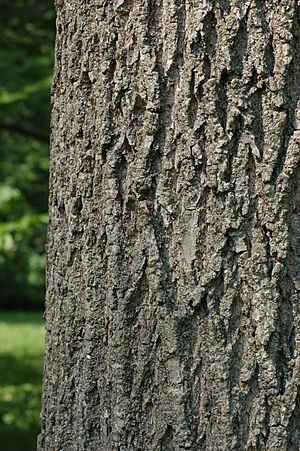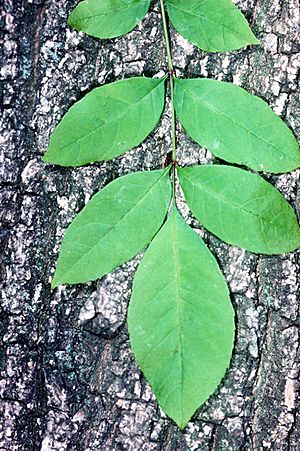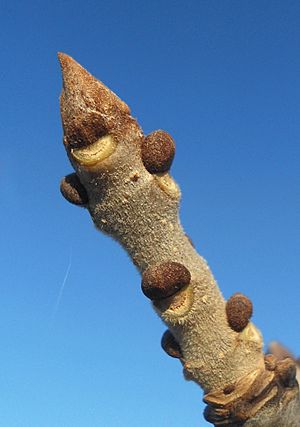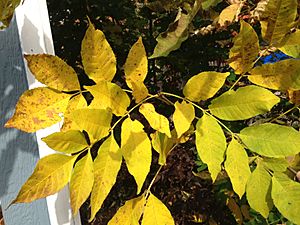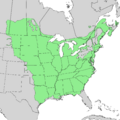Green ash facts for kids
Quick facts for kids Green ash |
|
|---|---|
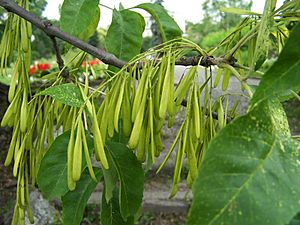 |
|
| Leaves and fruit | |
| Conservation status | |
| Scientific classification | |
| Genus: |
Fraxinus
|
| Species: |
pennsylvanica
|
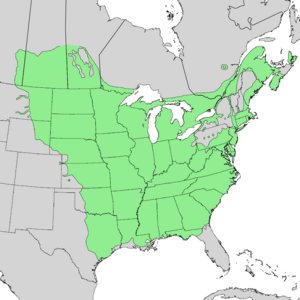 |
|
| Natural range of Fraxinus pennsylvanica | |
The Green Ash or Red Ash (its scientific name is Fraxinus pennsylvanica) is a type of ash tree. It grows naturally across a large part of eastern and central North America. You can find it from Nova Scotia in Canada all the way south to northern Florida in the U.S. It has also spread to other parts of the western United States and even to Europe.
People sometimes call this tree by other names like downy ash, swamp ash, or water ash.
Contents
What Does a Green Ash Tree Look Like?
The Green Ash is a medium-sized deciduous tree. This means it's a tree that loses its leaves every autumn. It usually grows about 12 to 25 meters (40 to 80 feet) tall. Some can even reach 45 meters (148 feet)! The trunk can be up to 60 centimeters (2 feet) wide.
When the tree is young, its bark is smooth and gray. As it gets older, the bark becomes thick with deep cracks. The winter buds are reddish-brown and feel soft, like velvet.
Leaves, Flowers, and Fruit
The leaves are about 15 to 30 centimeters (6 to 12 inches) long. Each leaf is made up of 7 to 9 smaller leaflets, but sometimes there can be 5 or 11. These leaflets are 5 to 15 centimeters (2 to 6 inches) long. Their edges are saw-toothed, and they have short, fuzzy stems. The leaves are green on both sides and turn a beautiful golden-yellow in the fall.
The flowers appear in spring when the new leaves start to grow. They are small and don't have petals, so they are hard to see. The wind helps spread their pollen. The fruit of the Green Ash is called a samara. It's about 2.5 to 7.5 centimeters (1 to 3 inches) long. Each samara has a single seed with a long, flat wing that helps it fly in the wind.
Green Ash trees are "dioecious." This means that some trees have only male flowers, and other trees have only female flowers. Both male and female trees are needed to make seeds.
Where Do Green Ash Trees Live?
Green Ash trees are the most common type of ash tree in America. They grow best near streams and in low, wet areas. Their many seeds provide food for lots of different animals.
The Emerald Ash Borer Threat
Unfortunately, Green Ash trees are in danger from a tiny beetle called the emerald ash borer. This beetle came to North America by accident from Asia. Most Asian ash trees have a lot of a chemical called tannin in their leaves. This makes them taste bad to the beetle, so the beetles don't eat them. But most American ash trees, like the Green Ash, don't have much tannin. This means they are easy for the beetles to eat and kill.
Scientists are looking for Green Ash trees that have survived the emerald ash borer. They hope these trees might have a special genetic resistance to the beetle. This could help bring Green Ash trees back.
Why the Beetle Spread So Fast
The emerald ash borer spread quickly because many cities planted a lot of Green Ash trees. This happened after a disease called Dutch elm disease killed many American elm trees in the 1950s and 60s. Cities wanted fast-growing trees that could handle city pollution. They planted so many ash trees that it created a "monoculture," meaning there was only one type of tree. This made it easy for the beetles to spread from tree to tree.
To avoid this problem again, cities now try to plant many different kinds of trees. This way, if one type of tree gets sick, not all the trees in the city will be affected.
Sometimes, cities use special sprays or injections to protect important ash trees from the emerald ash borer. Also, very cold winters can kill many of the beetle larvae.
How Are Green Ash Trees Used?
City Trees
Green Ash trees are very popular for planting in cities and towns across the United States and Canada. They are liked because they grow into a nice shape and can handle tough city conditions, like pollution and road salt. They are also easy to grow. In some cities, like Edmonton, Alberta, about 40% of the trees planted along streets are Green Ash.
For a long time, American elm and ash trees were the most popular trees planted in cities. They were chosen because they could survive well and grow into beautiful, long-lasting trees.
Helping Wildlife
North American ash trees are very important for many animals. For example, the leaves that fall from ash trees are a critical food source for tadpoles in ponds and puddles. Other trees, like maples, don't provide as good a food source for frogs. This is because American ash trees have low tannin levels, which is good for tadpoles but also makes them vulnerable to the emerald ash borer.
Ash trees also provide homes and food for many other creatures native to North America.
Other Uses for the Wood
The wood from Green Ash trees is very similar to the wood from white ash trees. It's often sold together as "white ash" wood. It's a popular wood for making electric guitars because it can be lighter than white ash but still gives a bright sound with a long ringing tone. Many famous guitar makers use ash wood for their guitars.
-
Winter twig of Fraxinus pennsylvanica. Green ash can usually be distinguished from white ash (F. americana) by its D-shaped leaf scars. In F. americana, the lateral buds are more deeply recessed within their corresponding leaf scars, giving the latter a more C-shaped appearance.
See also
 In Spanish: Fresno rojo americano para niños
In Spanish: Fresno rojo americano para niños



